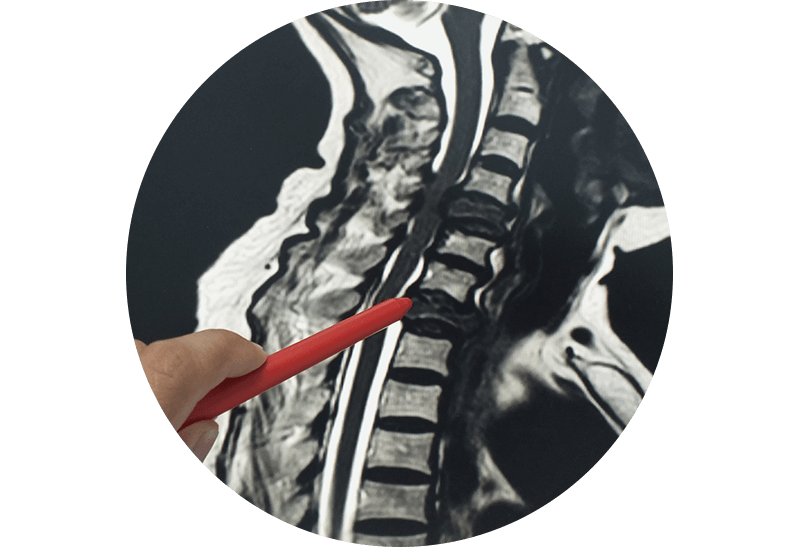Cervical Foraminotomy or Decompression (not performed at this time)

Cervical foraminotomy or decompression is performed using minimally invasive techniques. This procedure is used to treat nerve pain caused by the narrowing of the opening (foramen) for the nerve. This narrowing can result from a disc herniation or spinal stenosis within the cervical (neck) area of the spine. A small portion of the lamina or facet may be removed depending on the location of the pathology.
The minimally invasive technique utilizes one small incision to allow the surgeon access to the affected area, and the soft tissue and muscles are gently dilated with a tubular system. This advanced procedure can be executed in less time and with less damage to the surrounding tissue, and with less pain to the patient, than the traditional open method of surgery.
How the surgery works
The patient is given a general anesthetic so that the patient is unconscious for the duration of the procedure. The patient is then placed prone (face down) on the operating table. After cleaning and sterilizing the surgical area, a small incision about 1.5 centimetres is made at the affected spinal level. An X-ray is used to confirm the proper location is being operated on. Soft tissue dilators are used to separate the muscle fibres. A tubular retractor is inserted over the dilators which are then removed. The procedure is then performed with the aid of a microscope and specialized instruments. Using special surgical tools, the surgeon will create a small keyhole to remove a portion of the lamina (the bone that comprises the back of the spinal canal) and part of the facet to relieve the compression on the nerve. Disc material or bone spurs may also be removed depending on the cause of the problem.
Once the procedure is completed, the incision is closed with dissolvable sutures and surgical tape (Steri-strips) will be placed. The incision will be covered with a small dressing.
Minimally invasive cervical foraminotomy and decompression surgery usually takes around 1 hour to complete.
Postoperative care
Minimally invasive cervical foraminotomy or decompression is performed as day surgery and you will be discharged from the surgical centre the same day. You will be provided with a set of postoperative instructions. Because there will have been less cutting or trauma to the muscles and tissues surrounding the affected spinal level than in traditional surgery, your level of pain in the surgical area following the procedure should be minimal. In the first 1 to 2 weeks following your spinal surgery, you are advised to refrain from moving or bending your neck excessively. As the pain subsides and your neck muscles regain their strength in weeks 2 to 3 following your surgery, you will be able to twist and bend your neck more freely. No heavy lifting within the first month following the procedure is advised.
Frequently Asked Questions
Because we perform cervical foraminotomy or decompression using minimally invasive techniques, your recovery time and pain will be reduced compared to the traditional open surgery method. It usually takes around two weeks following your minimally invasive surgery before you can return to work in a reduced capacity. If your pain is subsiding and your neck strength is recovering, you can often return fully to work and recreational activities around 4 to 6 weeks after the procedure.
Cervical foraminotomy or decompression surgery has been shown to be extremely successful in addressing narrowing of the nerve canal due to disc herniation or spinal stenosis. Studies indicate patients typically report their results as being either good or excellent between 84-95 per cent of the time, with patients noting a rapid and significant reduction in previous pain and the ability to return to most if not all of their regular or recreational pursuits.
This type of minimally invasive spinal surgery requires very little wound care. You will leave the surgical centre with a small dressing and this should be left on for three days. After three days, the wound can be uncovered and exposed to air. The surgical tape keeping the suture in place should not be touched and the area where the incision has been made should be kept dry and clean. When taking a shower, the wound should be covered by a bandage and care should be given to ensure you do not get water directly on it. Bathing is not recommended until roughly five days after the procedure.
Receive the care you need right away
Horizon Surgical can expedite your minimally invasive spine surgery to be done in a timely fashion. From beginning to end, you can typically receive your minimally invasive spine surgery within a couple months. With our reduced recovery times, you’ll be able to get back to living your life and doing what you love most right away.
Call Us
Contact Us
- Phone: 403-619-2288
- Fax: 403-685-8137
Hours
- Hours of Operation:
Monday: 9:00am-4:00pm Tuesday: 9:00am-4:00pm Wednesday : 9:00am-4:00pm Thursday: 9:00am-4:00pm Friday - Sunday: Closed
